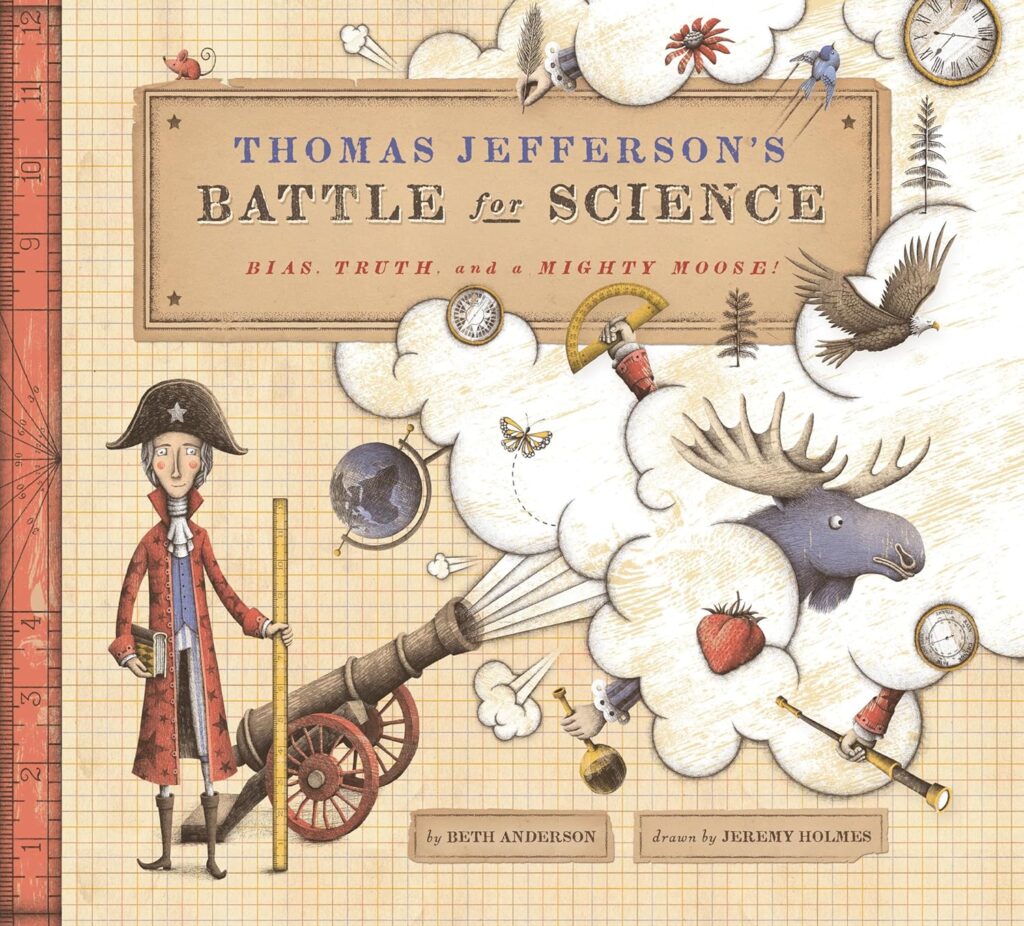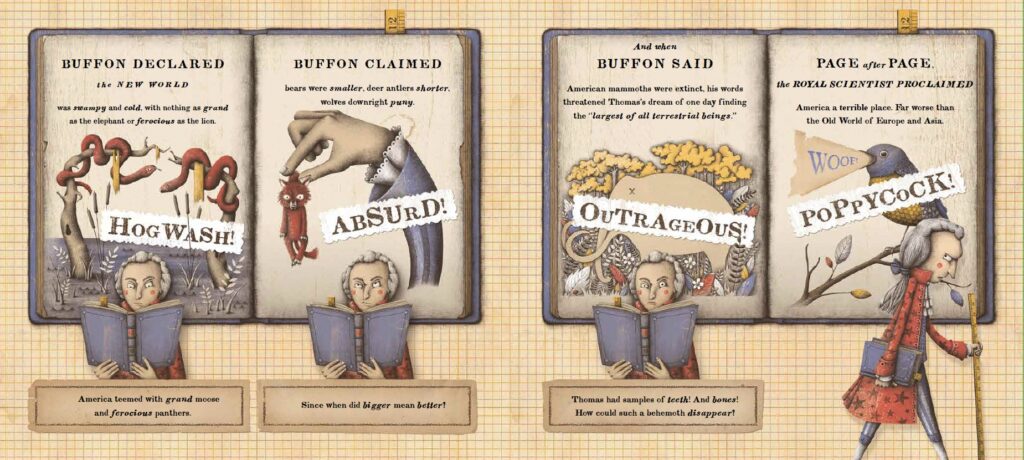My first thought, upon seeing the cover of this book by my friend Beth Anderson and illustrated by Jeremy Holmes, was “Wow. I HAVE to read this.” There’s so much going on that I wanted to investigate!

My second thought was “Uh-oh.” Because wasn’t there already another book on this same topic? Um, yes, there was. Sort of. That one’s called Jefferson Measures a Moose, and it’s by Mara Rockliff/S.D. Schindler. I like that one so much I talked about it here on PBB last August. The good news for everybody involved is that the two are very different from one another, each a terrific model of modern, appealing nonfiction.
As it turns out, Beth chose to focus on the scientific method. SMART! The final product is voice-y, lively, and a joy to read. Jeremy Holmes clearly had a blast taking Beth’s nonfiction story and blowing it up into a package that is irresistible! But don’t take my word for it. The book has garnered THREE stars, from The Horn Book, Kirkus, and Booklist. They used phrases like “delightfully enlightening” and “theatrical flair.” Here’s a sample spread:

Of course I had to ask Beth a few probing questions (nonfiction author brain-picker that I am), and she was kind enough to fill us in.

Jill: Coming upon a topic that makes a nonfiction writer’s radar *ping!* is such a heady feeling … but it isn’t like we dive into research immediately. At least I don’t. Instead, those one-line ideas (or a copied/pasted para or article) go into some kind of “idea file” to await their moment. How do you decide when the time is right to tackle one of those specific projects?
Beth: First, huge thanks, Jill, for featuring THOMAS JEFFERSON’S BATTLE FOR SCIENCE on this amazing blog!
This is such a great question as I seldom think about it. I have several levels of “idea lists.” But every once in a while an idea catches my attention and demands immediate attention. And if the shout crescendos as I find connection, potential, and relevance… I’m a goner. It never makes it to the idea list—it’s awarded a pocket folder, spiral, and a spot on my desk. 😊 And sometimes pushes another WIP to the back of the line.
I think there are really three factors that determine what I work on. Priority goes to the manuscript or idea nearest and dearest to my heart—the one I’m most excited about. Another factor involved is the clarity of the angle or the “heart” of the story. If I haven’t found it, that project may have to sit awhile. And sometimes it’s our moment in history and the need for a certain story ASAP. There have only been a few times when I’ve actually gone to my idea list, because I always seem to have a few special ones waiting.
Sometimes, as in the case of THOMAS JEFFERSON’S BATTLE FOR SCIENCE, that initial spark for a potential story morphs along the way. I had already latched onto the idea of Jefferson’s obsession with mammoths, not quite sure what I would do with it, when I saw an announcement for a new book about that. I put the idea on hold, and later stumbled on a related incident I loved more: Jefferson fighting back against Count Buffon with a moose. This much more specific anecdote had more appeal for me and a range of possibilities. The angle that hit me was the concept of “measuring truth.” (It was 2018.) After working on that for more than a year, I saw another book announcement….yep…you guessed it…Jefferson and the moose. But I was in too deep to quit. And what I was going after seemed different than the description in that announcement. Cancel the discouragement. Full speed ahead! By then I understood there can be more than one book on a topic like this, and the lengthy publishing process meant anything I did wouldn’t be out for a couple years anyway. To be perfectly honest, I have a really hard time giving up on a manuscript completely after I’ve invested so much of myself in it for so long. But it does happen.
While an idea full of potential angles can be a challenge to frame and focus, it offers many possibilities for moving the direction of the story.
Jill: That’s definitely an appealing idea. But, whoa. I didn’t realize there were TWO competing Jefferson books (sorry, other author). I think most of us deflate upon discovering there’s already a book on “our” topic – and give up. Great to hear that may not always be the only (or best) option.
So, next question: Of your published books, which was the toughest in any of these areas: educating yourself on a topic out of your realm (What I mean: like with TJ, do you have a science background?), finding supporting materials, honing a focus, or making the information/topic accessible for kids? I know, that’s a lot. Feel free to pick and choose.
Beth: I learn so much from every book—not only about history, but also about writing as each manuscript presents specific challenges. My background as an elementary and middle school ESL teacher which exposed me to subjects across the curriculum has been really helpful for the kinds of books I write.
The book that stretched me the most was LIZZIE DEMANDS A SEAT!—I knew nothing about that place and time. But that was one of the reasons I dug into it. I wanted and needed to understand that history, and at a deep level, emotionally and intellectually. The limited information on Elizabeth Jennings forced me to really dig into all aspects of setting and society. From there I could begin to comprehend the impacts on her, motivation, stakes, and risk. Her actions took on deeper meaning. Elizabeth Jennings taught me so much!
Jill: Love hearing how you made yourself an expert!
Beth: When I go after an idea and get into the research, I tend to see too much in it, so the tight focus is always something I have to wrestle with for a while. THOMAS JEFFERSON’S BATTLE FOR SCIENCE was definitely a challenge to hone. There’s so much on him, and I always struggle with the temptation to reference touchstones kids know. The Declaration of Independence and its “truths” seemed to fit with the story at first when I was exploring larger unmeasurable truths as a contrast to the provable ones. But that idea ended up too complex and better left to a mention in back matter. Another aspect that proved difficult was making Buffon’s theory and the concept of bias accessible for kids. The quadraped animals were just one part of the argument in Buffon’s theory of degeneration in North America, and Jefferson collected information in three categories: animals common to the Old World and New World, species diversity, and domesticated animals. The comparison of quadrapeds across continents was the most kid-friendly as it dealt with size, so I narrowed the scope and tried to simplify the issues. As I worked and reworked Jefferson’s actions to create a scene, I (eventually!) realized that he was actually using a scientific inquiry process much like what’s used in science classes today. I had already landed on the phrase “think like a scientist” which is used with kids, but the inquiry process gave me a framework that allowed me to expand on that with a specific process that serves educators and clearly illustrates how that critical thinking plays out. That was huge! From the start, a major goal was to show the importance and process of critical thinking, and I’d finally found the path. And illustrator Jeremy Holmes did such a fantastic job of enhancing the science throughout—I hope readers will pore over the pages and all his fabulous details!

Jill: Oh, this table is GOLD. I can see why you were hooked, Beth. The illustrations for this newest book are some of my favorites. They add so much humor and elevate the book’s appeal. That’s what leads me to this question: When you submitted this particular manuscript (or any!), did you call out specific text or set it off in some way to clue in an illustrator, in this case Jeremy Holmes? Those of us in the trenches know authors and illustrators rarely have the privilege of collaborating. But, whew, it sure feels that way in this book, where each page is a perfect marriage of text and art.
Beth: I am so amazed by how Jeremy Holmes meshed text and art! Truly! I usually provide some notes for the editor and illustrator in a separate section just to offer any vital nonfiction specifics. Though Jeremy may have used a few bits from the notes (like who Jefferson wrote letters to in a couple spots), he did so much research on his own that he found his own pieces he wanted to add in the illustrations.
I wrote the manuscript as I always write. I shy away from lengthy paragraphs, preferring to affect the read by how I put text on the page—with hanging sets of phrases in spots, with exclamations, with line drops, and occasional words in italics. Nothing was designated for illustrations. Instead of saying Jeremy chose some of those pieces to use in the art, I think it would be more accurate to say he masterfully meshed text and art. My arrangement and format of the text on the page likely influenced the form it all took within the illustrations. (I would love to know how he moved from manuscript to sketches!) Some of my italicized exclamations went into special boxes in the art. And Jeremy added more of those. A few of my short phrases went into little white boxes. And he created more that serve as character commentary, add humor, and sharpen tone. Some of my line drops went into sequential panels in the art—which really enhanced the pacing that I intended with my line drops. And he used two sets of my hanging phrases and an introductory phrase list in a format that visually supports the science aspect of the whole book. While I had an epigraph quote to start the story, Jeremy brought much more to that, too. The only piece we sort of collaborated on (through the editor during vetting) was the primary source letter and bones from John Stuart when we had to replace a different letter. Jeremy said in an interview that he tries to create an “experience,” and he surely did!
Jill: Thanks for stopping by, Beth! This book is absolutely awesome, and I hope people will check it out asap! Meanwhile, if any of you readers want to read more about the making of this book, take a look here, here, or here.
And if you’d like the chance to win a copy of your own, simply leave a message for Beth below. THANKS for hanging out with us at PBB!

Clearly, topics turn into multiple books, but finding the unique focus makes a book stand out. Thanks for bringing special books and interesting interviews to the page.
Thanks so much for stopping by, Joyce! I tend to think it’s all about how to focus – and that can be sooooo hard!
Can’t wait to read this, Beth!
Thanks, Jody!! Hope you enjoy the book!
What brilliant writing and a unique approach when we think we know everything about Thomas Jefferson!
Always fun to see a wider person in those we think we “know.” Historically and… every day!!
Now more than ever we need books that explore bias and focus on the science. Of course, throw a moose in there, fun words, and voice, and kids are hooked! Always happy to see another Beth Anderson book enter the world!
Thanks, Laura! I love being able to mix humor with the serious stuff! 🙂
I recently read this book and loved it. I always love hearing the process behind books so thank you so much for this post!
Thanks for the book love, Debra!
All Beth’s books are wonderful! Can’t wait to read this one! Such an interesting interview, too.
Thanks, Kim! Jill always asks questions that make you think 🙂
Such a great interview! And I LOVE this book! Quirky, informative and fascinating!
Oh, thank you, Linda! That means so much!
Jill and Beth, thanks for a wonderful interview! Beth, I love that you didn’t give up on your book even when Mara’s came out. There is definitely room for both! Congratulations!!!
Thank you, Vijaya!
Thanks for enlightening us on the evolution of this book! Kudos on championing the scientific process over hogwash & poppycock! 👏👏You moose be very proud!🫎😉
Thanks for that fun comment! Yes – digging past the hogwash is still important – imagine that! 😆
This nis such a superb interview, Beth and Jill. It offers insights for young readers, for teachers and librarians, but especially for writers. The book is gem on every level and Beth is, too!!
Oh, thank you Sandy for your book love and kind words! You are another one of those dig deep interviewers! I love that because you spur realizations we get to the meat!
This looks wonderful. We history buffs often have to compete with STEM enthusiasts. I love when history and science are teamed up!
Me too! History and science each inform the other – I love it!
How cool! Thanks for sharing!
Thanks for stopping by, Katie!
I can’t wait to read this book and learn facts about Jefferson that aren’t in mainstream history books or biographies. It sounds like the illustrator was the perfect pick for this manuscript.
Jeremy Holmes was indeed the perfect pick for this manuscript! He totally got my intentions. 🙂
This book looks so fun! Love the illustrations.
Thanks, Zachary!
This book sounds great.
Thanks for stopping by Destiny!
I love hearing more of the story behind this story–fascinating! I’m so excited to share your newest book with my students and teachers!
Thanks Jolene! I’m always happy to do a virtual Q&A too to discuss anything of interest. 🙂
Thank you, Beth, for describing your writer’s journey, the bumps along the way to finding a unique angle for Jefferson’s story and never giving up. A valuable lesson for writers and non-writers. Congrats on a beautiful book.
Thanks so much, Sandra!
The waitlist at my library is so long that I am still waiting eagerly to read this. Such an interesting and generous interview, and so wise especially regarding Heart. Like your blog on the subject, a treasure trove. Thank you, Jill and Beth!
While I’m thrilled there’s a waitlist 😃 I’m sorry you have to wait! So glad you enjoy my blog – so many people have shared great insights.
Congrats on your latest book, Beth! I look forward to reading this one.
Thank you, Susan!
Beth, what an interesting STEM book! Congratulations!
Thanks so much, Kathy!
Awesome, Beth! Congratulations!
Thanks, Angie!